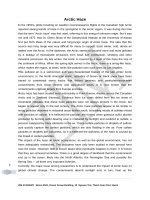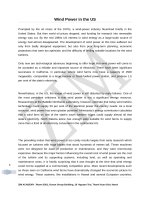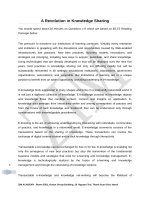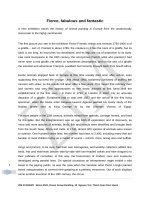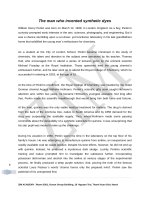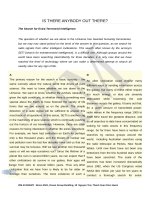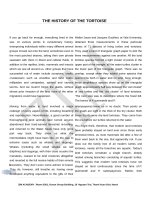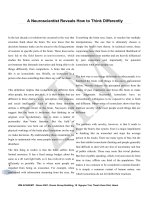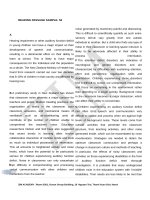IELTS academic reading sample 123 is there really a war on drugs
Bạn đang xem bản rút gọn của tài liệu. Xem và tải ngay bản đầy đủ của tài liệu tại đây (73.61 KB, 5 trang )
You should spend about 20 minutes on Questions 1 – 13 which are based on Reading
Passage 123.
Is There Really a War on Drugs?
A
In our c ontemporary society, the media constantly bombards us with horror stories about
drugs like crack-cocaine. From them, and probably from no other source, we learn that crack
is immediately addictive in every case, we learn that it causes corruption, crazed violence,
and almost always leads to death. The government tells us that we are busy fighting a war
on drugs and so it gives us various iconic models to despise and detest: we learn to
stereotype inner-city minorities as being of drug-infested wastelands and we learn to
"witchhunt" drug users within our own communities under the belief that they represent
moral sin and pure evil. I believe that these titles and ideals are preposterous and based
entirely upon unnecessary and even detrimental ideals promoted by the government to
achieve purposes other than those they claim.
B
In Craig Renarman's and Harry Levine's article entitled "The Crack Attack: Politics and
Media in America's Latest Drug Scare," the authors attempt to expose and to deal with some
of the societal problems that have resulted from the over-exaggeration of crack-cocaine as
an "epidemic problem" in our country. Without detracting attention away from the serious
health risks for those few individuals who do use the drug, Renarman and Levine
demonstrate how minimally detrimental the current "epidemic" actually is.
C
Early in the article, the authors summarize crack-cocaine's evolutionary history in the U.S.
They specifically discuss how the crack-related deaths of two star-athletes which first called
wide-spread attention to the problem during the mid 1980's. Since then, the government has
reportedly used crack-cocaine as a political scapegoat for many of the nation's larger innercity problems. Thefts, violence, and even socioeconomic depression have been blamed on
crack. They assert that the government has invested considerably in studies whose results
could be used to wage the constant "war on drugs" while to politicians, that war has
1
amounted to nothing more than a perceptual war on poverty and urban crime.
D
ZIM ACADEMY | Room 2501, Ocean Group Building, 19 Nguyen Trai, Thanh Xuan Dist, Hanoi
Since politicians have had little else of marketable interest to debate over the years, this
aggressive attack on drugs has existed as one of their only colorful means by which to
create debate, controversy, and campaign fuel. In other words, when balancing the budget
and maintaining an effective foreign policy became too boring to handle, Reinarman and
Levine assert that the "crack epidemic" became the focus of politicians with the intent of
luring public interest to their flashy anti-drug campaigns.
E
Finally, in addition to the media's excess attention on the 'war against drugs,'Reinarman and
Levine make the point the constant coverage of crack in the news media has only been
counterproductive to the alleged goals of any anti-drug program. With descriptions of the
"crack high" that glorify it considerably-the politically-charged media campaigns to fight drugs
have worked somewhat ironically as huge advertising campaigns for crack-increasing public
awareness and stimulating the interests of venturous junkies.
F
While Reinarman and Levine are rather adamant about their findings, they do maintain an
overt respect for the reality that crack has had other causal factors and outcomes besides
those described by them. Their main concern seems to be calling for a more realistic
spotlight to be placed upon the problem- so that we can begin to deal with it as no more and
no less than what should be.
G
The "war on drugs" is indeed based upon an exaggeration of facts. Although it is also
evident that substances such as crack-cocaine may serve to pose great health risks to those
that use them, there is not any widespread "epidemic" use of the drug nor any validity to the
apparent myths that it causes such immediate devastation and is life-wrecking in every
single case.
It is obvious that we do indeed need to maintain a greater and more focused emphasis on
the important and more widespread problems in society. Important energies and well1
needed monies are being diverted from them to fight in an almost-imaginary battle against a
controlled substance. Conclusively, we should allow drugs like crack-cocaine receive their
ZIM ACADEMY | Room 2501, Ocean Group Building, 19 Nguyen Trai, Thanh Xuan Dist, Hanoi
due
attention
as
social
problems,
but
let
them
receive
no
more
than
that!
_________________________________________________________________________
Questions 1–4
Choose the appropriate letter A–D and write your answers in boxes 1–4 on your answer
sheet.
1. From the media we learn that crack-cocaine ...
A. gives us various iconic models to despise and detest.
B. represents moral sin can evil.
C. is addictive in every case, causes corruption and violence and almost always leads to
death.
D. bombards us with horror.
2. According to Craig Renarman and Harry Levine, ...
A. crack-cocaine is an ̳epidemic problem‘ in our country.
B. crack-cocaine does not pose serious health risks for users.
C. the current e
̳ pidemic‘ is really very serious.
D. the current e
̳ pidemic‘ is not so serious despite the serious health risks for the few
individual users.
3. Based on Paragraph C, we know that ...
A. crack-cocaine became widely know as a problem since the mid -1980s.
B crack-cocaine has caused many problems –from thefts, violence to socio-economic
depression.
C. the government has invested little fighting the w
̳ ar on drugs‘.
D. drugs have led to political as well as social problems.
4. Politicians use the drug issue ...
A. to attack the drug dealers at the market.
B. to lure the public interest to their flashy anti-drug campaign.
C. to balance the budget and maintain an effective foreign policy.
D. to attack drug users only.
1
Questions 5–6
Complete the table below describing the causes and effects. Write your answers in boxes 5–
6 on your answer sheet.
ZIM ACADEMY | Room 2501, Ocean Group Building, 19 Nguyen Trai, Thanh Xuan Dist, Hanoi
CAUSES
EFFECTS
Example
Answer
crack-cocaine
corruption, violence and deaths
media‘s excess attention on the war against drugs‘ …………5………..
Politically-charged media campaigns to fight drugs
…………6………..
Questions 7–13
Do the following statements agree with the views of the writer in Reading Passage 123?
In boxes 7-13 on your answer sheet write
YES if the statement agrees with the writer
NO if the statement does not agree with the writer.
NOT GIVEN if there is no information about this in the passage
7. In our contemporary society, people all over the world should launch a war on drugs.
8. Drug users within our won communities represent moral sin and pure evil.
9. The ̳war on drugs‘ waged by the government is really a perceptual war on poverty
andurban crimes.
10. Druguses may lead to poverty and divorce.
11. We should spend more money and maintain a more focused emphasis on the
importance and more wide-spread problems in society rather than on an almost imaginary
battle against drugs.
12. We should not pay too much at tention to drug users, instead, we should fight against the
drug dealers.
13. Drugs like crack-cocaine has received much more attention than is necessary.
1
ZIM ACADEMY | Room 2501, Ocean Group Building, 19 Nguyen Trai, Thanh Xuan Dist, Hanoi
Answer:
1. C
2. D
3. A
4. B
5. counterproductive to the alleged goals of any anti-drug program
6. increasing public awareness and stimulating the interests of venturous junkies
7. No
8. No
9. Yes
10. Not given
11. Yes
12. Not given
13. Yes
1
ZIM ACADEMY | Room 2501, Ocean Group Building, 19 Nguyen Trai, Thanh Xuan Dist, Hanoi
